Exterior of Auschwitz I Gas
Chamber
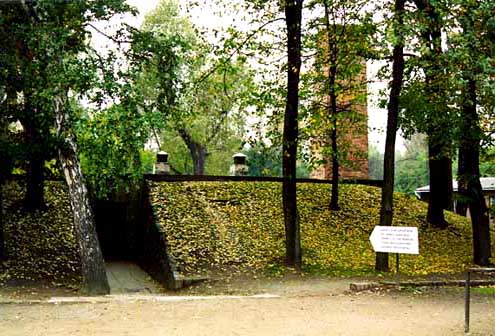 Outside entrance into
gas chamber in 1998
Outside entrance into
gas chamber in 1998
The photo above, which shows one of the
two entrance doors into the Krema I gas chamber in the Auschwitz
main camp, was taken in October 1998 on a guided tour. At that
time, tourists were told that this was the entrance used by the
prisoners when they were herded into the gas chamber.
The problem is that this door was not
cut into the building until after the gas chamber was converted
into a bomb shelter by the Nazis in the Fall of 1944. In their
award-winning book entitled "Auschwitz 1270 to the Present,"
authors Robert Jan van Pelt and Deborah Dwork include a copy
of the blueprint for the plans to convert the crematorium into
an air raid shelter. The blueprint shows that the door in the
photo above was added in 1944.
The gas chamber building at Auschwitz
I was located outside the barbed wire fence which surrounds the
barracks, but inside the grounds of the camp. The door shown
below is on a camp street, in close proximity to the office of
the Commandant. The bomb shelter was for the SS men and this
new door was a more convenient entrance for them. The building
for the camp Political Department (Gestapo) was right next door
to the gas chamber building and the SS hospital was across the
street.
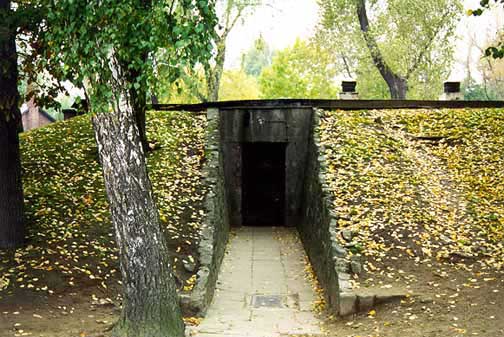 Door for bomb shelter
was cut in 1944
Door for bomb shelter
was cut in 1944
The photograph above shows another view
of the entrance, taken in 1998. The outside door opens into a
tiny vestibule, the floor of which is level with the walkway
leading up to the door. Inside the vestibule, a door on the left
opens into the gas chamber, which had been converted into a bomb
shelter by the time the camp was liberated by the Soviet Union
on January 27, 1945. The outside door, shown in the photo above,
has a peephole with no glass. Anyone looking through this peephole
from the outside would only be able to see the back wall of the
tiny vestibule.
The two things sticking up on the roof,
as shown in the photo above, are chimneys or vents over the area
where two of the cremation ovens are located. Barely visible
in this picture is the faint trail up the grassy slope on the
right side of the entrance, made by visitors who have climbed
up on the roof to see the holes through which the Zyklon-B gas
pellets were dropped into the gas chamber below. The building
is on level ground, but dirt was piled up against the outside
walls in order to keep the bodies in the morgue cool.
According to Jean-Claude Pressac, who
wrote "Auschwitz: Technique and Operation of the Gas Chambers,"
the location of the crematorium in the main camp was formerly
the site of a kitchen. Other sources say that the crematorium
was constructed by remodeling an ammunition depot.
According to van Pelt and Dwork, no Jews
were killed in the Auschwitz I gas chamber during all of 1941,
when the only prisoners that were gassed were Soviet Prisoners
of War. According to a book by Danuta Czech, the last gassing
in Krema I was in early December 1942. "The last victims
were several hundred prisoners of the Sonderkommando in Birkenau
who were employed in the killing operations."
According to a book entitled "Auschwitz"
which I purchased at the museum, gassing was discontinued in
the Auschwitz I gas chamber in March 1942 and the whole process
was moved to Auschwitz II or Birkenau where two old farm houses,
known as the "little red house" and the "little
white house," had been converted into make-shift gas chambers,
known as Bunker 1 and Bunker 2. The two farm houses were used for
gassing until March 1943 when the gas chamber in Krema II at
Birkenau was put into operation.
The crematorium at Auschwitz I continued
to be used to burn corpses until July 1943 when four new crematoria
were in full operation at Birkenau.
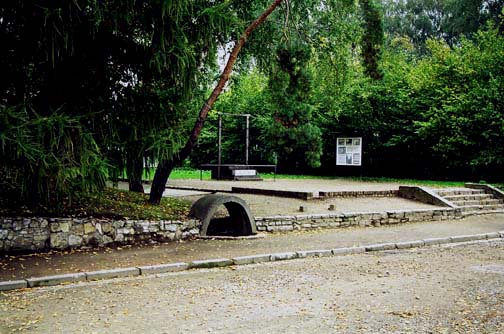 Gallows where Commandant
Rudolf Höss was hanged
Gallows where Commandant
Rudolf Höss was hanged
The photo above shows the reconstructed
gallows on which Rudolf Hoess, the Commandant of Auschwitz, was
hanged on April 16, 1947. The steps on the far right in the photo
are the original steps of the building which housed the Political
Department (Gestapo branch office). One can see the outline of
where the building once stood. The reconstructed gallows stands
on the spot where the Political Department building used to be.
The small hole in the ground with an
arched covering over it, located next to the street, is a one-man
air raid shelter for an SS guard to jump into, in case there
was no time to make it into the air raid shelter in the former
gas chamber. There are several of these shelters scattered around
the Auschwitz I camp. During air raids the prisoners would take
cover in the basements of the barracks buildings.
The Auschwitz complex was targeted by
the Allies, not because the Jews were being gassed here, but
because the factories near the camp were extremely important
to the German war effort. In 1944, Auschwitz I received a direct
hit from Allied bombs and one of the barracks buildings was damaged.
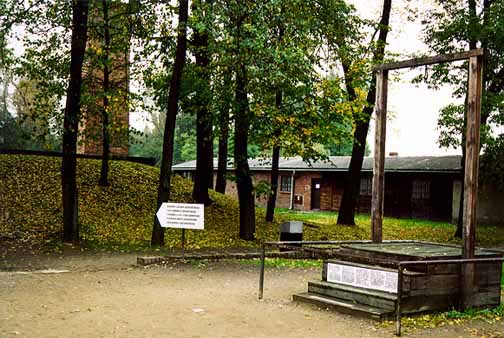 Gallows with crematorium
chimney in background on the left
Gallows with crematorium
chimney in background on the left
The photo above shows another view of
the gallows with the gas chamber and crematorium building behind
it to the left. The brick building in the background is one of
the SS buildings outside the camp. The tall brick chimney is
a reconstruction of the one that was used for the cremation ovens.
The reconstructed chimney is not connected to the reconstructed
ovens inside.
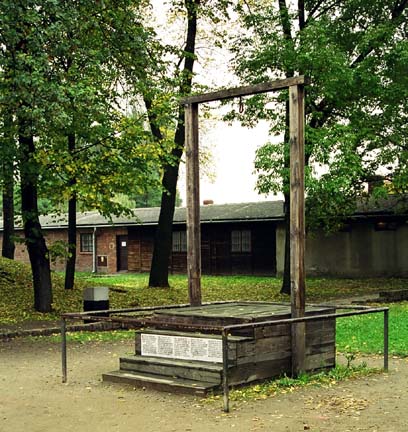 Gallows where Commandant
Rudolf Hoess was hanged
Gallows where Commandant
Rudolf Hoess was hanged
The photo below shows the SS hospital
which was directly across the street from the Auschwitz gas chamber.
The gas chamber is behind the camera to the right. From the windows
of this building, the prisoners who worked there could witness
the SS men on the roof, wearing gas masks, as they poured Zyklon-B
pellets through the holes into the gas chamber.
 Early morning shot
of the SS hospital across from the gas chamber
Early morning shot
of the SS hospital across from the gas chamber
This page was last updated on August
12, 2007
|